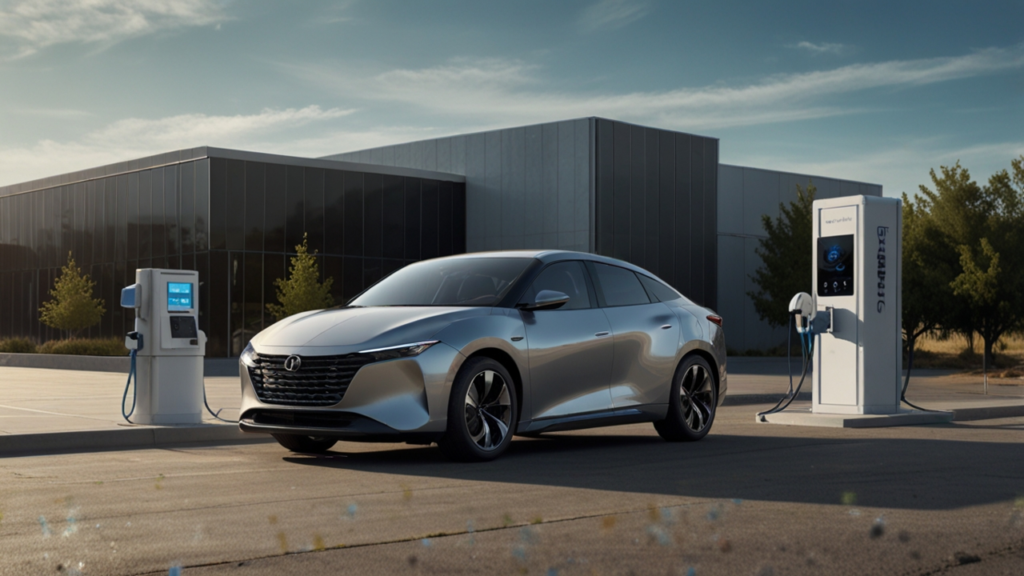Vehicle-to-Grid Technology: 6 Energy Benefits
Welcome to our in-depth exploration of a transformative approach in modern sustainability. In this article, we delve into how vehicles have evolved from mere transportation tools into valuable assets for energy management. Our discussion is designed to be engaging and accessible, so you can easily grasp this innovative technology.
This discussion touches on historical developments, current applications, and the future trends shaping the integration of vehicles with power networks. We invite you to explore the fascinating journey of harnessing mobile batteries for grid support. For more information on future mobility, check out Future Mobility.
Prepare to discover detailed examples, statistics, and insights that underline the potential of this technology to revolutionize sustainable practices around the globe. Have you experienced any innovative energy solutions in your community?
Table of Contents
- Introduction to Vehicle-to-Grid Technology
- Evolution and History of Vehicle-to-Grid Technology
- How Energy Storage Enhances Vehicle-to-Grid Technology
- Grid Integration Systems and Their Applications
- Real-World Case Studies of Vehicle-to-Grid Technology
- Electric Vehicles in Modern Vehicle-to-Grid Technology Solutions
- Future Trends: Power Management and Beyond
Introduction to Vehicle-to-Grid Technology
Overview and Basic Principles
The core idea behind this innovative system is that vehicles can play a dual role by not only consuming energy but also supplying excess energy back into the network. This approach empowers them with the ability to stabilize fluctuations, enhance reliability, and ultimately contribute to a more sustainable energy landscape. Pioneered in the late 1990s, early experiments in the US, Europe, and Japan laid the groundwork for modern applications.
Early pilot projects leveraged bidirectional charging capabilities, which allowed vehicles to recharge on demand while also feeding energy back when necessary. This method relies on sophisticated digital communication and smart hardware to optimize energy flows and forecast demand. Detailed research on the subject helps us understand that the balance between consumption and supply is vital for energy stability.
For more information on advanced transportation innovations, see Electric Vehicles. What alternative uses for common technologies have you observed recently?
Key Concepts and Terminology
This approach is built on several essential technical concepts, such as bidirectional chargers, smart meters, and cloud-based control systems. In its simplest form, these components work together to manage energy flows seamlessly between the vehicles and the network. The system’s success depends on reliable, two-way communication protocols that ensure both charging and energy return are efficiently controlled.
Standard protocols like ISO 15118-20 have been developed to enable interoperability among different manufacturers and utility systems. This standard is a driving force behind global deployment, as it guarantees that devices from varied sources work harmoniously within the same grid framework. For more information on technical standards, consider reading detailed discussions at industry white paper.
Does this blend of technology and tradition spark ideas for new solutions in your area?
Evolution and History of Vehicle-to-Grid Technology
Origins and Early Experiments
The foundations of this system began with theoretical work in the late 1990s and early 2000s. Researchers proposed using vehicle batteries not just for transportation but as distributed energy hubs. Early pilot projects in countries like the US, Japan, and Europe demonstrated the feasibility of these concepts by focusing on bidirectional charging mechanisms.
These initial experiments laid the groundwork for policies and technical standards that would embrace vehicle-based energy contributions. One notable achievement was the gradual development of ISO 15118-20, which has now become a cornerstone in ensuring seamless communication between vehicles and the grid. For detailed historical insights, refer to a globally accepted policy document.
How do you think early experiments influence current renewable initiatives?
Commercial and Regulatory Advancements
As the concept matured, several key regulatory bodies and market players stepped in to support its commercialization. The development of supportive policies and robust standards accelerated the integration of this technology. By 2024, market size assessments indicated the global segment reached values of approximately $5.54 billion, with forecasts predicting expansion to $49.75 billion by 2034.
Government incentives in North America and Europe have actively promoted these developments by backing research and infrastructure projects. For a detailed market analysis, consult the research available at market size report. Could such rapid growth be replicated in other sectors?
How Energy Storage Enhances Vehicle-to-Grid Technology
Bidirectional Charging and Smart Infrastructure
The principle of bidirectional charging allows vehicles to draw in and send out energy. This process is essential for achieving equilibrium during peak loads. By employing advanced inverters and smart meters, vehicles can participate in both charging and energy discharge seamlessly. Sophisticated cloud-based control systems help manage this process in real time, ensuring that energy is available to balance supply and demand.
Such smart infrastructural solutions provide the digital backbone that makes real-time energy exchange possible. For further details on the technology’s deployment, consider reading insights from US Department research. Can you think of other technologies that rely on similar bidirectional functionalities?
Artificial Intelligence in Managing Energy Flows
Artificial Intelligence (AI) plays a pivotal role in regulating the timing and amount of energy exchanged. Leveraging machine learning algorithms, the system predicts energy consumption patterns, optimizes battery health, and manages fleets of vehicles as virtual power plants. Such approaches enhance the efficiency of energy distribution, reducing waste and ensuring availability during peak demand periods.
This predictive capability is indispensable for maintaining system reliability across diverse grid operations. The application of AI ensures that the energy management system adapts dynamically to changing conditions, which is crucial for sustainable operation. For a closer look at the role of AI in this field, refer to the study at government report. How might AI continue to reshape infrastructure in the coming years?
Grid Integration Systems and Their Applications
Standards-Based Communication Protocols
The integration of vehicles with the grid relies heavily on standards-based communication protocols, which allow different systems to exchange data effectively. These protocols, established by international standardization organizations, ensure that the technical components across multiple vendors work in unison. This integration is vital for real-time management and stability.
For example, the ISO 15118-20 standard facilitates a secure link between vehicles and energy networks, ensuring that charging and discharging occur without conflict. This standard has been a key driver for commercial acceptance in markets where regulation is stringent. For more insights on communication standards, please view the reference at technical overview. What benefits do you see in standardizing inter-device communication?
Practical Applications in Diverse Energy Systems
These precise communication protocols enable vehicles to be integrated with renewable energy sources, balancing intermittent supplies like wind and solar power. The versatile nature of these systems supports not only large-scale operations but also localized energy management solutions. By acting as distributed energy nodes, vehicles contribute to a more robust and adaptive energy grid.
This paradigm shift means that even small fleets can support community-level energy resilience. In regions with high renewable penetration, this integration reduces reliance on conventional energy plants. Such a system is particularly useful in urban areas, where energy demand is highest. How can local communities benefit most from these innovations?
Real-World Case Studies of Vehicle-to-Grid Technology
Successful Implementations Across Regions
Various regions have implemented pilot projects that illustrate the potential of the technology. In the United States, California school buses have been adapted to provide grid support, earning additional revenue for districts while enhancing local resilience. Meanwhile, European projects like the Parker Project in Denmark successfully demonstrated grid balancing with Nissan vehicles.
Similarly, in Japan, Nissan Leaf models have been deployed to serve as emergency power backup during disasters. These cases exemplify how the technology can serve multiple purposes, from reducing peak load to providing critical support during emergencies.
For additional examples, read more about these initiatives in the global market report. Have you witnessed similar innovative projects in your locality?
Comparison Table of Global Initiatives
The following comparison table provides detailed insights into several vehicle-based energy initiatives across the globe.
Comprehensive Comparison of Case Studies
| Region | Project Name | Energy Impact | Key Outcome (%) |
|---|---|---|---|
| USA | California School Bus Pilots | Grid resilience and revenue generation | 5-10% |
| Europe | Denmark Parker Project | Frequency regulation and balancing | Up to 10 MW supplied |
| Japan | TEPCO/Nissan Demos | Emergency backup during disasters | Critical support |
| Australia | ARENA Trials | Residential and commercial renewable support | Steady integration |
| South Korea | KEPCO Initiatives | Stabilizing renewable storage | Enhanced reliability |
For more information on this technology application, please refer to government assistance resources. What innovative element from these case studies stands out to you?
Electric Vehicles in Modern Vehicle-to-Grid Technology Solutions
Current Applications in Transportation Fleets
Modern fleets are increasingly equipped with this dual functionality, transforming vehicles into dynamic energy assets. In the U.S., fleets such as school buses have shown that integrating energy return features leads not only to economic benefits but also strengthens grid resilience. These vehicles exchange energy seamlessly, ensuring stable supply during low renewable generation periods.
Fleet operators are finding that this approach reduces peak generation stress and opens new revenue streams. Such initiatives are driven by a combination of smart technology and strategy, which is reinforced by government-backed programs. For an in-depth review, please check additional details at industry reports. Can you imagine the potential benefits for public transportation systems?
Integration with Modern Urban Infrastructure
Urban centers are rapidly adapting to integrate these advanced systems into their infrastructure. The focus is on ensuring that vehicles contribute to the overall energy balance in metropolitan environments. This transformation supports critical services during peak hours and enhances emergency responses. City planners are now considering mobile energy storage as a crucial component of sustainable urban design.
In practice, this means that vehicles can supplement traditional power sources in smart cities, thus improving overall energy reliability. As urban populations grow, such integration will become central to maintaining a robust energy network. Reflect on how your local community could adopt similar solutions. Have you noticed any similar smart city initiatives?
Future Trends: Power Management and Beyond
Emerging Market Developments and Policies
Looking ahead, industry forecasts indicate that the market is projected to reach nearly $50 billion by 2034. Technological advancements, such as improved battery durability and enhanced standardized protocols (ISO 15118-20), are set to drive these trends forward. New government regulations and incentives are continually emerging, fostering an environment ripe for innovation.
Key policy frameworks are being updated worldwide to include mandatory features for newer vehicle models. Regions like Asia-Pacific are expected to lead these shifts as countries scale up their infrastructure investments and refine technical standards. For more analysis on market dynamics, refer to the comprehensive market research report. What future policy changes do you believe will most impact this field?
Technological Innovations and Grid Adaptations
The shift towards decentralized energy systems is gathering pace, where millions of vehicles serve as distributed energy reserves. At the same time, emerging innovations in digital control platforms enhance coordination, making it possible for entire fleets to operate as virtual power plants. These adaptive infrastructures not only boost efficiency but also pave the way for broader community-level energy solutions.
New AI models are being developed to further optimize operational processes, reducing operational costs and extending battery lifespans. Additionally, next-generation communication protocols are anticipated to improve energy transfer efficiencies even further. With these technological leaps, urban and rural energy systems alike will benefit from more resilient operations. How might these innovations change the way local power grids operate?
Vehicle-to-Grid Technology Excerpt Insight
This captivating segment offers an exciting preview of transformative advancements in the modern energy landscape. In recent developments, pioneering strategies have unlocked surprising efficiencies that challenge conventional frameworks of resource allocation and time-honored operational practices. Notably, emerging infrastructures have proven adept at improving reliability while simultaneously reducing transactional hurdles. Cutting-edge applications reveal that traditional models can be reimagined in innovative, flexible structures that accommodate unexpected challenges. The narrative revolves around adaptive solutions designed to transform everyday systems. Audiences are invited to contemplate how evolving technological paradigms might reshape our understanding of resource management across various sectors. The discussion goes deeper than routine improvements, presenting a striking new perspective on efficiency and scale. This inspiring journey serves to remind us that progress often unfolds through creative integrations that bridge gaps between established methodologies and future potentials. The takeaway is clear: forward-thinking solutions are essential for crafting dynamic, resilient systems that not only meet present challenges but also anticipate tomorrow’s demands.
Could this fresh mindset be the catalyst for further breakthroughs in how we approach everyday challenges?
FAQ
What is the basic concept behind this technology?
The concept involves repurposing vehicles to not only consume power but also to supply excess energy back to the network. This dual functionality helps stabilize demand and enhance energy efficiency.
How did early experimental projects influence current applications?
Early experiments established the feasibility of bidirectional charging and laid the groundwork for global standards and market acceptance. Pilot projects in the US, Europe, and Japan were particularly influential.
What role do communication protocols play in the system?
Standards-based protocols, such as ISO 15118-20, ensure effective two-way communication between vehicles and the power grid, enabling seamless energy exchange and real-time control.
Which sectors benefit most from these innovations?
Various sectors—from urban transportation fleets to emergency response systems—benefit remarkably. The technology not only reduces peak demand but also provides backup during outages.
What future trends are anticipated in this field?
Future trends include market expansion, enhanced AI-driven control systems, improved battery durability, and increased decentralization of energy resources.
Conclusion
This exploration into the world of Vehicle-to-Grid Technology has shed light on the many energy benefits that are transforming modern energy systems. From historical experiments to futuristic innovations, the path has been filled with insightful breakthroughs that highlight how we can effectively harness mobile power resources.
We have seen compelling examples where real-world case studies have demonstrated the dual-use capabilities of vehicles. The blend of advanced hardware, standardized protocols, and AI-driven management underscores the vast potential of this approach. Could this integration be the key to a smarter, more resilient energy future?
As we continue to evolve, public and private sectors must work together to create supportive regulatory frameworks and invest in technologies that optimize energy dynamics. Your thoughts and experiences are important—share them in the comments or Contact us to join the conversation. For more information, explore related articles and resources from trusted industry sources.
Have you encountered similar trends in your community? What changes do you foresee in the way energy is managed in the future?
Discover more from Fabelo.io
Subscribe to get the latest posts sent to your email.



